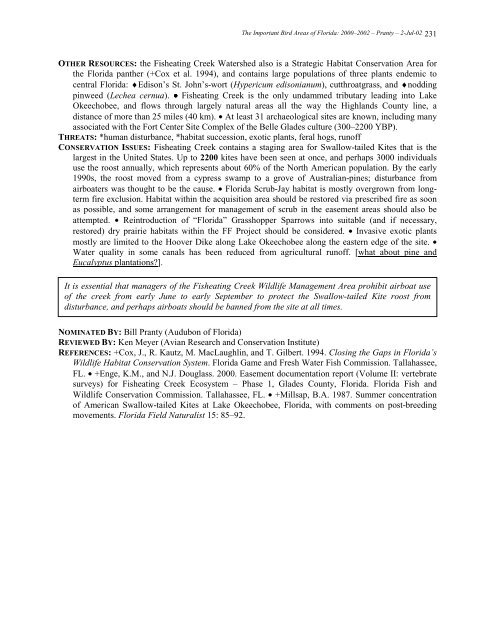The Important Bird Areas of Florida - National Audubon Society
The Important Bird Areas of Florida - National Audubon Society
The Important Bird Areas of Florida - National Audubon Society
Create successful ePaper yourself
Turn your PDF publications into a flip-book with our unique Google optimized e-Paper software.
<strong>The</strong> <strong>Important</strong> <strong>Bird</strong> <strong>Areas</strong> <strong>of</strong> <strong>Florida</strong>: 2000–2002 – Pranty – 2-Jul-02 231OTHER RESOURCES: the Fisheating Creek Watershed also is a Strategic Habitat Conservation Area forthe <strong>Florida</strong> panther (+Cox et al. 1994), and contains large populations <strong>of</strong> three plants endemic tocentral <strong>Florida</strong>: ♦Edison’s St. John’s-wort (Hypericum edisonianum), cutthroatgrass, and ♦noddingpinweed (Lechea cernua). • Fisheating Creek is the only undammed tributary leading into LakeOkeechobee, and flows through largely natural areas all the way the Highlands County line, adistance <strong>of</strong> more than 25 miles (40 km). • At least 31 archaeological sites are known, including manyassociated with the Fort Center Site Complex <strong>of</strong> the Belle Glades culture (300–2200 YBP).THREATS: *human disturbance, *habitat succession, exotic plants, feral hogs, run<strong>of</strong>fCONSERVATION ISSUES: Fisheating Creek contains a staging area for Swallow-tailed Kites that is thelargest in the United States. Up to 2200 kites have been seen at once, and perhaps 3000 individualsuse the roost annually, which represents about 60% <strong>of</strong> the North American population. By the early1990s, the roost moved from a cypress swamp to a grove <strong>of</strong> Australian-pines; disturbance fromairboaters was thought to be the cause. • <strong>Florida</strong> Scrub-Jay habitat is mostly overgrown from longtermfire exclusion. Habitat within the acquisition area should be restored via prescribed fire as soonas possible, and some arrangement for management <strong>of</strong> scrub in the easement areas should also beattempted. • Reintroduction <strong>of</strong> “<strong>Florida</strong>” Grasshopper Sparrows into suitable (and if necessary,restored) dry prairie habitats within the FF Project should be considered. • Invasive exotic plantsmostly are limited to the Hoover Dike along Lake Okeechobee along the eastern edge <strong>of</strong> the site. •Water quality in some canals has been reduced from agricultural run<strong>of</strong>f. [what about pine andEucalyptus plantations?].It is essential that managers <strong>of</strong> the Fisheating Creek Wildlife Management Area prohibit airboat use<strong>of</strong> the creek from early June to early September to protect the Swallow-tailed Kite roost fromdisturbance, and perhaps airboats should be banned from the site at all times.NOMINATED BY: Bill Pranty (<strong>Audubon</strong> <strong>of</strong> <strong>Florida</strong>)REVIEWED BY: Ken Meyer (Avian Research and Conservation Institute)REFERENCES: +Cox, J., R. Kautz, M. MacLaughlin, and T. Gilbert. 1994. Closing the Gaps in <strong>Florida</strong>’sWildlife Habitat Conservation System. <strong>Florida</strong> Game and Fresh Water Fish Commission. Tallahassee,FL. • +Enge, K.M., and N.J. Douglass. 2000. Easement documentation report (Volume II: vertebratesurveys) for Fisheating Creek Ecosystem – Phase 1, Glades County, <strong>Florida</strong>. <strong>Florida</strong> Fish andWildlife Conservation Commission. Tallahassee, FL. • +Millsap, B.A. 1987. Summer concentration<strong>of</strong> American Swallow-tailed Kites at Lake Okeechobee, <strong>Florida</strong>, with comments on post-breedingmovements. <strong>Florida</strong> Field Naturalist 15: 85–92.
















